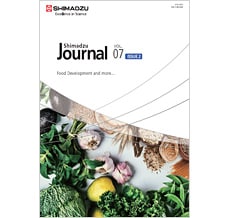Vol.7, Issue2-January 2020 CONTENT
Featuring Food Development
 |
Shimadzu Journal Vol.7, Issue2-January 2020 (5,042 KB)
Food Development
|
 |
[Insight from Customer] Interview with Prof. Erich Leitner (Page 40-41) We interviewed Professor Erich Leitner from Graz University of Technology in Austria. Professor Erich Leitner is a leading expert on food quality. He is a major node in the local food network, having strong relations with local food producers and farmers in the region. |
 |
[Food Development]
Mineral oil (MO) residues in food raised public concern due to some elevated concentrations up to several thousand milligrams per kilogram food. The determination of MOSH and MOAH in food can be done by an automated LC-GC-FID system for routine analysis. Unfortunately, some food material like rice or chocolate contain natural occurring alkanes which can interfere and heavily disturb the analysis of the MOSH fraction. This sutdy reports these interferences can be removed by flash chromatography on aluminium oxide columns. |
 |
[Food Development]
Development of a High Sensitivity Analytical Method for Quantitative Analysis of Trace Amounts of D-Amino Acids (Page 44-49)
When the steric structure of amino acids was devised, it revealed that most amino acids could exist as mirror-image isotopes that are differentiated by an L-/D- notation into L-amino acids and D-amino acids. More recently, it is starting to appear as if some foods and particularly microorganism-associated fermented foods contain D-amino acids, and the function of these foods is gaining interest. In this article, the authors intend to explain a new analytical method for D-amino acids that uses a high-sensitivity triple quadrupole mass spectrometer and describe an example application of this method in fermented food analysis. |
 |
[Food Development]
Determination of garlic phenolic compounds using supercritical fluidextraction coupled to supercritical fluid chromatography/tandemmass spectrometry (Page 50-51) A rapid, simple and environmentally friendly supercritical fluid extraction and supercritical fluid chromatography coupled to mass spectrometry (SFE-SFC-MS/MS) method has been developed for the analysis of nine phenolic compounds in garlic. Through the optimization of the SFE parameters using response surface methodology (RSM), 15 phenolic compounds were successfully extracted at 50ºC in 9 min with the addition of 30% methanol using a method that was automatic, efficient, green and prevented oxidation. Moreover, the operating conditions of the SFC-MS/MS were also optimized for the analysis of the SFE extracts. 15 phenolic compounds in the garlic showed good separation performance on a Shim-packUC-X Diol column, and 0.1 mM oxalic acid and 1 mM ammonium formate in methanol were chosen as the most suitable mobile phase components.
|
 |
Shimadzu Selection (Page 52-53)
These article were selected by Shimadzu. Relating food analysis and development, they are from posters presented at ASMS 2019 and from application notes. They feature a variety of instruments we produce and include cutting-edge technologies.
Please obtain the articles of your interest through the links on the titles. |
 |
[Topics 1]
Global Innovation Summit 2019 (Page 54-55)
Shimadzu Corporation held the “Shimadzu Global Innovation Summit 2019” from 9th-10th July. This year’s event, on the theme of “Pioneering Partnerships for Advanced Healthcare”, saw a diverse pool of 93 researchers from 21 countries travelling to Shimadzu’s headquarters in Kyoto. |
 |
[Topics 2]
Food Safety seminar by SEG (Page 56-57)
For several years, the companies Shimadzu and Merck have been offering food safety seminars that introduce a wide range of new applications, as well as tips and tricks for use in the food laboratory. In addition to the extensive lecture program, it provides an excellent platform for dialogue and exchange between experts in food production, control, and research & development. |
 |
[New Products] |



